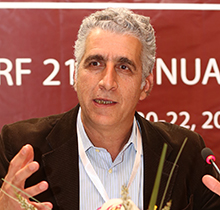In a nutshell
Rather than expending huge resources attempting to enforce harsh lockdowns, governments in poorer countries should consider implementing more nuanced strategies adapted to local conditions.
Such strategies could focus on protecting high-risk populations, especially the elderly, while expanding healthcare capacity as much as possible and allowing healthy younger people to return to work.
Governments must ensure the wide dissemination of credible and up-to-date information about Covid-19, especially to the poorest households, which tend to have the least access to online or traditional news sources.
The effects of developed countries’ Covid-19 lockdowns are reverberating around the world, with collapsing commodity prices and tourism, falling remittances, and rising borrowing costs pushing developing-country governments to the breaking point. As poor countries move to impose similar restrictions, they risk not only compounding the economic shock, but also jeopardising the lives of those who cannot afford to stay home.
Debraj Ray and Sreenivasan Subramanian recently said what many of us were have been thinking: India cannot afford a general, mandatory and sustained Covid-19 lockdown. Their argument is not based on a dubious ‘value-of-life’ calculation, which pits lives lost to Covid-19 against economic growth or stock market performance.
Rather, the authors look beyond the ‘spiraling macroeconomic downturn’ to the ‘protracted stress on household incomes, employment, and nutrition, ultimately measured in human lives and not in rupees.’ Simply put, they are weighing the lives saved through social distancing against the lives lost to lockdown-induced violence and starvation.
In countries without robust and reliable safety nets, those in low paid, precarious jobs – such as in the sprawling informal sector – can go hungry after even a few days out of work. For them, breaking the law quickly becomes a matter of survival. The longer the lockdown lasts, the more likely starvation, social unrest and violence become.
The response of India’s migrant workers – for many of whom lockdown has also meant the loss of shelter – exemplifies this danger. Almost immediately after the lockdown was announced in India, hundreds of thousands of migrant workers set off on foot from cities to their home villages. When the lockdown was extended, protests erupted, with migrants demanding that, at the very least, they be allowed to take trains home.
Rather than expending huge resources attempting to enforce harsh blanket lockdowns, governments should consider designing and implementing more nuanced strategies adapted to local conditions. As Ray and Subramanian advocate, such strategies could focus on protecting high-risk populations, especially the elderly, while expanding healthcare capacity as much as possible. Healthy younger people would be allowed to return to work.
While anyone can contract Covid-19 and even suffer severe symptoms, the elderly are by far the most likely to die. Most recent estimates in Italy and China, confirmed by more recent data from New York, show that the case fatality rate for those under the age of 50 was only 0.2% (age 10-19) to 0.4% (age 19-49). That rate rose to 1.3% for those aged 50-60; 3.6% for those aged 60-70; 8-13% for those aged 70-80; and 15-20% for people over the age of 80.
Mortality rates will be higher in poorer environments where health systems are notoriously weak. Even among the working age population, death and long-term health damage can be very high in the absence of good healthcare. Isolating the elderly will also improve the capacity of the healthcare system by preventing it from becoming overwhelmed, thus improving the prospects of everyone else that contracts the virus.
The good news is that most poor countries have younger populations than their rich counterparts. One reason for Italy’s high mortality rate is the large share of elderly people: around 23% of the country’s population is over the age of 65. In middle-income countries, that share drops to around 10%, with the exception of China, where it stands at 16%. In the poorest countries, that proportion drops further. In Africa, it averages about 5%.
Yet isolating the elderly does present a significant logistical challenge in poor countries, where people tend to live in larger, multigenerational households. In northern Europe, around 90% of seniors live alone or with their spouse. In Africa, that share plummets to about 10%. The risk that poses are again on display in Italy, where high rates of infection among the elderly partly reflect a social model that involves a lot of intergenerational interaction, with multiple generations often sharing a home.
To be sure, age is not the only Covid-19 risk factor. Experience in high- and middle-income countries shows that mortality rates rise sharply among people with at least one chronic underlying condition, such as cardiovascular or diabetes.
In poorer countries, especially those with high food insecurity or large refugee populations, communicable diseases (tuberculosis, malaria and HIV) are more common. Though we do not yet know how these diseases will affect Covid-19 mortality rates, we should consider affected people a priori at risk.
The question is how to isolate the vulnerable, while allowing the rest to return to work. The answer will vary from place to place, depending on living conditions, culture and even architecture. In most cases, the specifics should be left up to communities, supported by generous state financing and, crucially, guided by accurate information.
To that end, governments must ensure the wide dissemination of credible and up-to-date information about Covid-19, especially to the poorest households, which tend to have the least access to online or traditional news sources. Given widespread mistrust of official sources – again, especially among the poor – governments should enlist the help of civil society organisations, religious institutions and traditional chiefs to spread information and engage with communities to develop workable coping strategies.
In rich countries, the ‘herd immunity’ approach to managing Covid-19 has been met with considerable resistance – and not without reason. But for the poorest countries, the risks that this approach raises can be dwarfed by the risks of starvation, destitution, instability and violence arising from a prolonged lockdown. Carefully managed efforts to build herd immunity could be a better bet for these countries.
But the virus is not confined by political borders. A differentiated strategy in poor countries leaves other countries exposed. This raises the additional global challenge of managing border controls for as long as it takes developing countries to build herd immunity or for a vaccine to become available.
Further reading
Wei-jie Guan et al (2020) ‘Clinical Characteristics of Coronavirus Disease 2019 in China’, New England Journal of Medicine, 18 February.
Graziano Onder, Giovanni Rezza and Silvio Brusaferro (2020) ‘Case-Fatality Rate and Characteristics of Patients Dying in Relation to COVID-19 in Italy’, Journal of the American Medical Association, 23 March.
Debraj Ray and Sreenivasan Subramanian (2020) ‘Covid-19: Is there a reasonable alternative to a comprehensive lockdown?’, Ideas for India, 28 March 28.
Robert Verity et al (2020) ‘Estimates of the severity of coronavirus disease 2019: a model-based analysis’, The Lancet, 30 March.
United Nations (2017) World Population Ageing 2017 – Highlights, Department of Economic and Social Affairs, Population Division.



